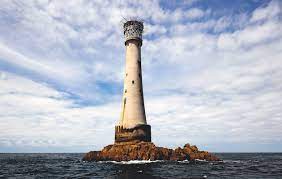
Did you know that more than 60 lighthouses dot the coast of England and Wales? For centuries Britain’s spectacular lighthouses have made the coastline a safe place by protecting seafarers from vengeful tides and hidden rocks. In years past, lighthouses were manned by brave men and women, often in the most remote but beautiful locations in the UK.
Even though the modern era has brought about automated lighthouses, this doesn’t mean that these iconic landmarks are forgotten. Nowadays, the many hidden lighthouse gems are a nostalgic reminder of the country’s extensive and historical relationship with the wide open ocean.
If you’re interested in the fascinating history and importance of UK lighthouses, you’ve come to the right place. In our blog, we’ve not only detailed the history and importance of UK lighthouses but also shared a few must-visit hidden gems that still silently guard our coastlines and sailors.
The History Of The UK Lighthouses
Before we have a closer look at the history of UK lighthouses, we want to briefly discuss the origins of the lighthouse.
The lighthouse of Alexandria, often referred to as the Pharos of Alexandria, is widely believed to have been the world’s first lighthouse. This lighthouse was more than 91 meters tall and the tallest man-made structure for centuries.
Unsurprisingly, lighthouses became a more common occurrence, but it wasn’t until the 18th century that they began being built in the UK. The 18th century is well known as the modern era of lighthouse construction, and England began building lighthouses because of international trade across the Atlantic Ocean and the country’s war efforts.
The first lighthouse in England was the Eddystone Lighthouse – the first created with a more modern aesthetic for the time. Unlike other lighthouses, the Eddystone was made to be significantly more durable because it was the first lighthouse to be in constant contact with the sea.
That’s why the designer of this lighthouse modelled the base after an oak tree. When this proved successful, it became an industry standard, and many more lighthouses have been built since with this in mind.
The Importance of Lighthouses In The UK
Now that you know more about the history of lighthouses in the UK, we thought it would be a good idea to discuss why they were and still are important.
Firstly much of the history in the UK would not have been possible without safe maritime travel, and the one thing lighthouses have always done well is provide a safe beacon to guide sailors and travellers back home. During the 18th, 19th, and 10th centuries maritime travel, trade, and transportation would have been far riskier without lighthouses.
Secondly, centuries ago and today, lighthouses signal when there is a nearby port or establishment where weary sailors and travellers can dock and rest. They also help vessels avoid reefs, dangerous rocks, and shallow waters, thus preventing damage to boats and ships, injuries, and loss of life.
Since lighthouses are so important to the history of the UK and those out at sea, they are managed by a board of engineers who intermittently perform maintenance and upkeep to preserve them.
What Are The Top Three Lighthouse Hidden Gems You Need To Visit In The UK?
With more than 60 lighthouses throughout the UK, narrowing down where you want to visit can be challenging. That’s why we’ve listed the top three hidden lighthouse gems that you should consider looking at when ready to get up close and personal with some of England’s maritime history.
1. Southwold Lighthouse
Trinity House began building Southwold Lighthouse in 1887 as a guide for ships sailing into Southwold Harbor and as a coastal mark for passing ships. In 1889 this cylindrical lighthouse replaced three others in the area that were under threat from coastal erosion.
Over the years, this 31-meter-tall lighthouse has become an incredibly popular attraction in Southwold since it is situated near the centre of the seaside resort. Despite almost closing in 2005, this lighthouse remains fully operational to this day.
Visitors can arrange a lighthouse tour and enjoy climbing the 113 steps to the top, where stunning sea views meet them. Should you visit, you can also expect to get first-hand experience with the inner workings of a functioning lighthouse.
2. Flamborough Head Lighthouse
Do you want to visit one of the oldest lighthouses in the world? The oldest complete lighthouse structure in the UK is the Flamborough Head Lighthouse, built in 1669. This lighthouse is also one of the oldest in the world, but what’s peculiar is that the tower is made out of chalk and has still managed to be around for more than 300 years.
Interestingly, Flamborough Head Lighthouse was designed by famed architect Samuel Wyatt and built by John Matson, and it only cost 8,000 pounds. Additionally, the original lighthouse apparatus was designed by George Robinson, and it wasn’t until 1940 that this lighthouse was electrified, and it wasn’t until 1996 that it was automated.
Moreover, many people don’t know that a rocket used to be launched from this lighthouse in foggy weather every five minutes to let sailors know where the safe ground was situated.
3. La Corbiere Lighthouse
One of the best lighthouses to visit if you’re an avid photographer and want to experience unequalled panoramic views and gorgeous sunsets is La Corbiere Lighthouse. This lighthouse can be found on the southwestern point of Jersey, and the lighthouse itself is connected to La Corbiere Beach via a tidal causeway.
Unfortunately, this lighthouse has some tragedy attached to it alongside its rich history. An assistant keeper of the lighthouse died in 1946 while trying to rescue a visitor. Yet, it’s not all doom and gloom as this lighthouse also carries within it a sculpture that represents a rescue of the Saint-Malo catamaran that took place in 1997.
Wrap-Up On The UK’s Lighthouse Hidden Gems
Hopefully, you now know more about the famous UK lighthouses and why they are worth visiting, alongside the captivating history and importance surrounding these spectacular structures. All that’s left is for you to choose which of the three hidden gems you should visit first!
